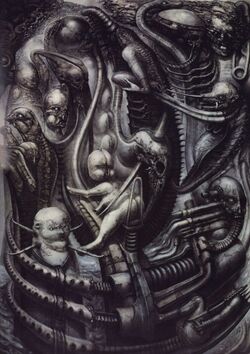Unspeakable horrors: Difference between revisions
>David Hedlund Undo revision 118980 by David Hedlund (talk) |
>David Hedlund Undo revision 118980 by David Hedlund (talk) |
(No difference)
| |
Revision as of 05:20, 23 December 2017

Unspeakable horrors can be described as the experience of prolonged exposure to ineffable scenarios and hallucinatory content of a scary and disturbing nature which are often directly influenced by one's fears. This can occur during high dose hallucinogenic experiences, particularly those in which the user is currently undergoing negative emotional stress and personal problems of an introspective nature.
Although the content which comprises these states are generally indescribable and largely dependent upon the fears of those who experience them, certain themes and archetypes often manifest themselves. These are not limited to but may consist of:
- Scenarios and plots of an intrinsically sinister and threatening nature - This can include scenes of suffering directed towards oneself or other people such as being tortured, scenes in which one is being hunted as prey by "evil" creatures or forces and the direct experience of personal fears.
- Settings, sceneries, and landscapes of an intrinsically sinister and threatening nature - This can include the visitation of hellish landscapes, ancient monolithic Lovecraftian architecture, and ruined civilizations.
- Autonomous entities of an intrinsically sinister and threatening nature - This can include demons, deformed monstrosities, hooded figures, mocking entities and otherwise normal human beings deformed by severe injury or illness.
- Machinescapes of an intrinsically sinister and threatening nature - This can be described as functionally identical to the experience of machinescapes. It differs in that its comprising parts often almost exclusively consist of indescribably complex interlocking, ever-shifting biomechanical gore, organs, disembowelments, and body parts.
- Geometry of an intrinsically sinister and threatening nature - The hallucinatory states listed above are commonly comprised of and embedded within standard hallucinogenic geometry. This often contains innately readable geometric representations of pure conceptual fear, horror, and suffering which can be felt through all of the senses they are perceived.
- Fearing for the fabric of one's sanity - This can be described as feelings that one's current perception is so horrific that they will surely be left permanently insane with severe psychological damage. The effect can leave people with an immediate sense that ordinary life is a thin shell over a comparatively horrifying reality which cannot be dismissed or escaped from. It is worth noting, however, that although stressful, this effect rarely leaves individuals with lasting psychological problems.
The experience of this component and how it is interpreted by those who undergo it seems to differ wildly between people. While most individuals can find this state to be traumatizing if unprepared, many people find that, although terrifying, it is potentially exhilarating and character building in equal measure. To ensure that one does not find themselves in this state unwittingly, heavy dosages of hallucinogens should be avoided without practice, and one should always work their way up to the higher levels from low dosages in small increments as they feel comfortable doing so.
Image examples
Psychoactive substances
Compounds within our psychoactive substance index which may cause this effect include:
Experience reports
Anecdotal reports which describe this effect within our experience index include:
- Experience: 18 mg 2C-I - Visually intense and strong bodily sensations
- Experience:2 tabs DOB - My DOB Nightmare
- Experience:5g Mushrooms - Failed attempt at a Terence Mckenna style trip.
- Experience:700mg Diphenhydramine trip
- Experience:Dem Shadow People and Such (A Retrospective)
- Experience:Unknown Dose DOC (Insufflated) - Overdosing and Terifying Ego Death
- Experience:~150mg MDA(oral) - a case of mistaken identity
See also
External links